#Cabling
Explore tagged Tumblr posts
Text

127 notes
·
View notes
Text
hold on do people normally just fucking. Drop their stitches for cables or is that just my friend
#Knitting#cabling#knitblr#I’m like oh hey!! What cable needles do you use?#and they turn around their work AND ITS JUST. DROPPED STIRCHES#NOTHING. NADA#AND THE CABLE WAS SUPERNCOMPLICATED TOO#NO PATTERN. NOTHING#this is also the same person who does biobowl like they invented it so
61 notes
·
View notes
Text

Edgware Road Underground Station platform with roundel and cabling
41 notes
·
View notes
Text

Roommate Christmas gift number 2! It felt good to do some cabling again.
Pattern on Etsy
10 notes
·
View notes
Text
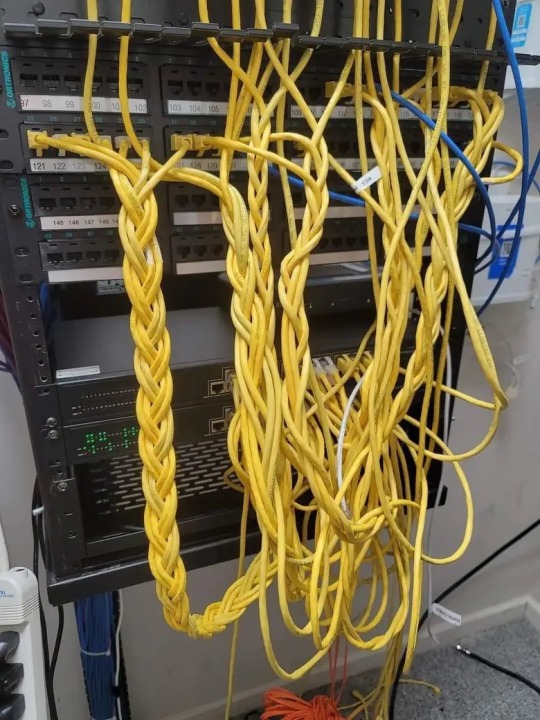
9 notes
·
View notes
Text

January 04, 2024
#paris#parijs#amsterdam#hat#knitting#paris hat#beanie#a cabling will go beanie#ravelry#benjamin matthews#malabrigo rios#knittingmojo#parisbeanie#love that pattern#great pattern#cabling
4 notes
·
View notes
Text
FTTA: High-Performance Solution for Integrated Optical Fiber and 5G Networks
There is a huge demand for high-speed data transfers in today’s mobile telecommunications networks. FTTA (Fiber-to-the-Antenna) is an essential element of 5G networks and ensures reliable, robust, and future-proof installation, improves user experience and reduces costs. This article helps you to understand FTTA.
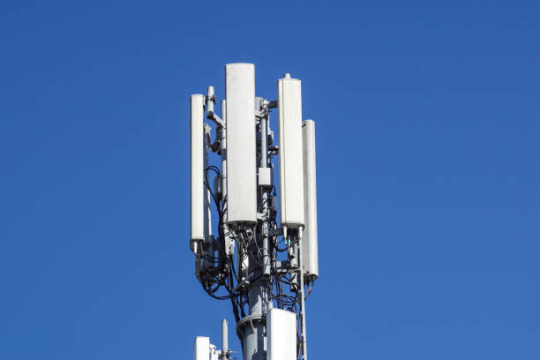
What is FTTA?
FTTA is a broadband network architecture to connect the building baseband unit (BBU) to the remote radio unit (RRU) at the top of the tower by using optical fibers to replace all or part of the coaxial network. FTTA can reduce the loss of signal power. And up to 20km's maximum transmission distance helps realize centralized placement of base stations (BS) in lower-cost telecommunication rooms and more flexible and modularized network planning.
FTTA Solution
FTTA solution reduces installation time and saves the cost of installation and maintenance. FTTA solution includes outdoor optic fibers, PDLC outdoor waterproof patch cords, terminal boxes, etc.
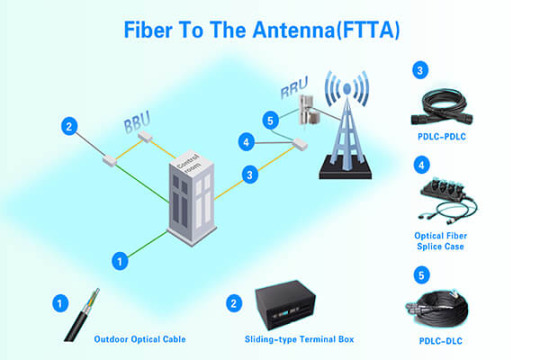
Benefits of FTTA
Perhaps the most benefit of FTTA stems from the physical content of the cable itself. The smaller diameter and lighter weight allow many fiber optic cables to occupy the same amount of space as a single coax cable. Because cellular towers are naturally subject to the elements, the physical size and properties of optical cabling are much less susceptible to damage from gusts of wind.
Other benefits of FTTA relate to the shift from analog to digital. Due to signal losses, the coax cable limited the distance between the antenna and the base station to as low as around 100m. Optical cabling can span up to 20 km with minimal losses.
FTTA provides improved energy consumption and signal integrity. Tower amplifiers are no longer required to combat the inherent noise floor of extended coax runs. The cooling of power amplifiers through air conditioning in a traditional base unit is replaced by ambient air cooling of the RRH, which significantly reduces the electrical power consumption of the system.
FTTA also provides flexible deployment, reduced complexity, saves installation time and space on the tower, lower investment, and high reliability.
Typical FTTA Scenario
Fiber optic networks aim to perform high-speed, error-free data transmission. Adequate testing during each phase of the network deployment guarantees that products meet specifications. It minimizes costly and time-consuming troubleshooting efforts, including locating dirty/damaged connectors, questionable splices, and other faulty components before they disrupt service.
One of the most crucial factors in ensuring proper transmission is controlling power loss in the network against the link loss-budget specifications from the network design recommendation, which establishes a total end-to-end loss budget with sufficient margin while reducing back reflection to a minimum.
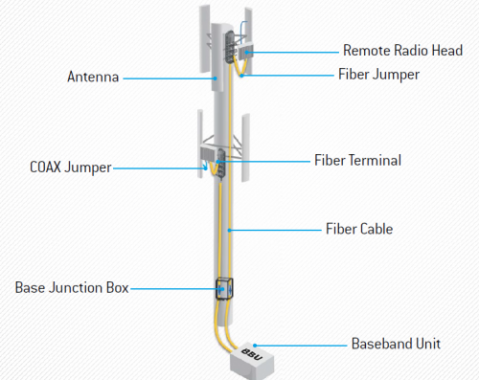
What is the Future of FTTA?
Consumer demand and technological advancement will continue to challenge the broadband infrastructure and necessitate more innovation. As incremental improvements such as active antennas integrated with the RRH to eliminate the need for all coax, small cell technology, and tower construction continues to evolve, it is safe to assume the future of FTTA may hold a few more surprises.
5G network provides speeds up to 100 times faster than 4G, which requires more small cell sites/DAS and improvements in conventional antenna tower bandwidth. Fiber optics will continue to provide the lifeblood to this ever-evolving network because only fiber can support the backhaul of these small cell sites produced by this intense proliferation of traffic.
Conclusion
FTTA is an innovative, flexible, and future-oriented way to install the network. It secures your network connectivity today and in the future.
Sun Telecom specializes in providing one-stop total fiber optic solutions for all fiber optic application industries worldwide. Contact us if you have any needs.
#suntelecom#fiberoptic#telecommunications#fttx#telecomengineering#cabling#osp#fiberopticcable#catv#telecomconsult
2 notes
·
View notes
Text
the things that are reported matters. the language used matters. what is left out of the story matters.
41K notes
·
View notes
Text
my family is fucking addicted to macgyvering and it's becoming a problem. every time something in this house breaks, instead of doing the sensible thing of replacing it or calling someone qualified to fix it, we all group around the offending object with a manic look in our eyes and everyone gets a try at fixing it while being cheered on or ridiculed by the rest.
it's a beautiful bonding activity, but the "creative" fixes have turned our house into a quasihaunted escape room like contraption where everything works, but only in the wonkiest of ways. you need a huge block of iron to turn on the stove. the oven only works if a specific clock is plugged in. the bread machine has a huge wood block just stapled to it that has become foundational to its function. sometimes when you use the toaster the doorbell rings. and that's just the kitchen.
it's all fun and games until you have guests over and you have to lay out the rules of the house like it's a fucking board game. welcome to the beautiful guest room. don't pull out the couch yourself you need a screwdriver for that, and that metal rod makes the lamp work so don't move it. it also made me a terrifying roommate in college, because it makes me think i can fix anything with enough hubris and a drill. you want to call the landlord about a leaky faucet? as if. one time my dad made me install a new power socket because we ran our of extension cords
#this post was inspired by me using a screwdriver to take the broiler off the wall because the warm water stopped working#while my dad went well there is only cables in there. who are we if we dont find our ways around some cables#damn right!!!!
61K notes
·
View notes
Text

0 notes
Text
Seattle Electrician

Larry's Electric - Seattle Electrician, Residential and Commercial Electrical Contractor Serving Seattle and King County, Washington

Seattle Electrician | Seattle and King County Washington Electrical Contractor

Larry's Electric provides professional residential and commercial electrician services and electrical contracting services in the Greater Seattle Metro, King County, Washington area.

Our licensed, professional, experienced journeyman electricians provide expert residential and commercial electrician services throughout Seattle, and King County.

Seattle Electrician service Serving the Greater Seattle and King County, and South Snohomish County Areas including the Seattle, Washington communities, Ballard, Shoreline, Edmonds, Magnolia, Capitol Hill, Queen Anne, Fremont, Wallingford, Wedgewood, Northgate, Lake City, Richmond Beach, Mountlake Terrace, Woodway, Lynnwood, Mukilteo, West Seattle, Lake Forest Park, Ravenna, University District, and Alki.

Why Choose Larry’s Electric in Seattle?

There are many reasons to choose Larry’s Electric as your electrician in Seattle, Washington. Here are just a few:
We are a licensed, bonded, and insured electrical contractor. Our electricians are highly skilled and experienced. We offer competitive rates and free estimates. We are committed to providing our customers with the highest quality of service.

Larry's Electric has been serving SeaTac, Seattle, Ballard, West Seattle, Shoreline, Bellevue, Kirkland, Tukwila, and King County home and business owners since 2009.

Contact Larry’s Electric today if you are looking for a reliable and experienced electrician in Seattle and King County, WA.

Residential Electrical Contracting and Residential Home Electrician Services
New Construction Electric Wiring and Panel Installation Remodel Construction Retrofit Electric Wiring and Connection Light Installation and Connectivity Electric Panel Installation and Wiring EV Charger / Electric Car Charger Panel Installation and Connection Back-Up Generator Installation and Connection Old House Wiring Renovation Upgrades Cable Networking and Low Voltage Data Wiring Outlets and Electrical Switches Pool and Hot Tube or Spa Wiring Heating and Air Conditioning Wiring Recessed Lighting and Track Lighting Security Lighting and Security Camera Wiring and Installation Circuit Breaker and Electrical Panel Installation and Wiring Electrical Code Violation Upgrades

Commercial Electrical Contracting and Industrial Electrician Services
New Commercial Business Construction Electric Wiring and Panel Installation Remodel Construction Retrofit Electric Wiring and Connection Light Installation and Connectivity Electric Panel Installation and Wiring EV Charger / Electric Car Charger Panel Installation and Connection Back-Up Generators Cable Networking and Low Voltage Data Wiring Outlets and Electrical Switches Heating and Air Conditioning Wiring Recessed Lighting and Track Lighting Security Lighting and Security Camera Wiring and Installation Circuit Breaker and Electrical Panel Installation and Wiring Electrical Code Violation Upgrades

Seattle Electrician Video
youtube
#seattle#electrician#electrical#contractor#king county#washington#residential#commercial#construction#EV Charger#Backup Generator#Lighting#Low Voltage#Ethernet#Cabling#Wiring#Electrical Panel#Ballard#West Seattle#Shoreline#WA#Youtube
0 notes
Text
IoT Installer’s Reality: Not just Screw ups

“Plug and play” is a high wire act. Installers have to verify connections, signal strength, and functionality before they climb down, or else they’ll be back up there fixing it. Without installers, there is no IoT, just a jumble of hardware. The work of securing devices, routing cables, making sure things actually connect is where the magic happens.
0 notes
Text
The Ultimate Guide to Structured Cabling Systems
Introduction
Structured cabling systems form the backbone of modern communication networks, providing a standardized and efficient way to manage data, voice, and video transmissions. This guide covers the fundamentals, benefits, components, installation best practices, and industry standards of structured cabling systems.
What is a Structured Cabling System?
A structured cabling system (SCS) is a comprehensive network of cabling and associated hardware that provides a universal infrastructure for various communication technologies. It supports multiple hardware systems and applications such as computers, telephones, and security devices, ensuring a seamless and scalable network environment.
Benefits of Structured Cabling Systems
Scalability - Easily accommodates growing network demands.
Cost-Effectiveness - Reduces maintenance and operational costs.
Flexibility - Supports multiple applications and technologies.
Improved Performance - Ensures high-speed data transmission with minimal interference.
Simplified Management - Centralized system makes troubleshooting and maintenance easier.
Enhanced Security - Provides a controlled and protected infrastructure.
Components of a Structured Cabling System
A structured cabling system consists of six main components:
Entrance Facilities - The point where external cabling connects to the building's network.
Equipment Room - Centralized space for network and telecommunications equipment.
Telecommunications Room (TR) - Houses connectivity equipment such as patch panels and network switches.
Backbone Cabling - Connects different TRs, equipment rooms, and entrance facilities.
Horizontal Cabling - Connects workstations and end-user devices to the TR.
Work Area Components - Includes cables, connectors, and outlets at the end-user level.
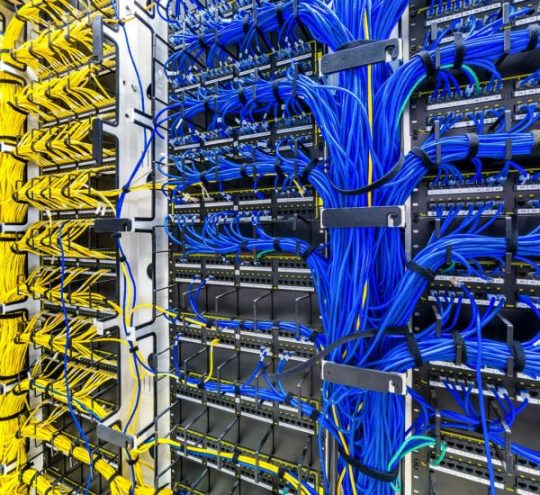
Industry Standards and Compliance
Structured cabling systems adhere to various industry standards, including:
TIA/EIA-568 - Telecommunications Cabling Standards
ISO/IEC 11801 - International Cabling Standards
BICSI Standards - Best practices for cabling installation and maintenance
NEC (National Electrical Code) - Electrical safety regulations
Installation Best Practices
To ensure an efficient and reliable structured cabling system, follow these best practices:
Plan for Future Growth - Design the system with scalability in mind.
Use High-Quality Components - Ensure all cables, connectors, and hardware meet industry standards.
Follow Labeling and Documentation Procedures - Maintain accurate records for easy management and troubleshooting.
Ensure Proper Cable Management - Use cable trays, racks, and pathways to organize cables neatly.
Adhere to Distance Limitations - Follow maximum cable length recommendations for optimal performance.
Test and Certify the System - Perform thorough testing to ensure compliance with performance standards.
Conclusion
A well-designed structured cabling system is essential for a reliable, scalable, and efficient communication network. A network cabling contractor ensures proper installation by adhering to industry standards, implementing best practices, and planning for future expansion. Businesses can optimize their infrastructure and ensure seamless connectivity by leveraging professional expertise. Whether setting up a new network or upgrading an existing one, investing in a structured cabling system is a strategic decision that yields long-term benefits.
1 note
·
View note

